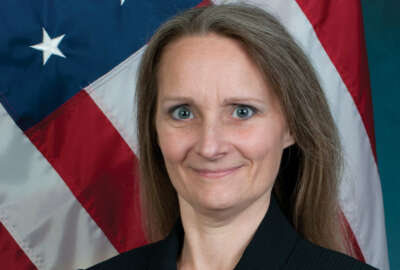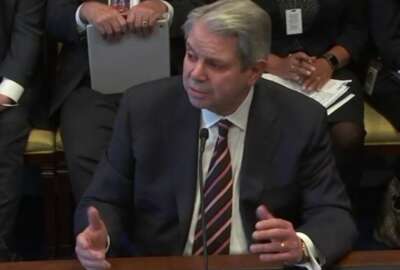
As CFO Act turns 30, agency financial officials draw up wish list for reform
The rapid expansion of the C-suite, along with the 30th anniversary of the CFO Act next year, has led agency financial officials to contemplate what they would like...
Best listening experience is on Chrome, Firefox or Safari. Subscribe to Federal Drive’s daily audio interviews on Apple Podcasts or PodcastOne.
Chief financial officers, for decades, have kept back-office operations running smoothly at their agencies. But the rapid expansion of the agency C-suite to include chief risk officers, chief procurement officers and chief data officers — to name a few — have led some CFOs to rethink the scope of their duties.
This year alone, the number of C-suite positions ticked upward with the passage of the Foundations for Evidence-Based Policymaking Act, which required agencies to name chief data officers and chief evaluation officers.
The rapid expansion of the C-suite, along with the 30th anniversary of the CFO Act next year, has led participants in an annual Grant Thornton and Association of Government Accountants survey to contemplate what changes they would like to see in the law, if Congress decides to revisit it.
In a survey of nearly 200 agency CFOs, deputy CFOs and other federal financial leaders, respondents agreed that a more consistent distribution of CFO duties across government “would heighten official and public understanding of central responsibilities and enable better strategic decision-making and operational oversight.”
Jay Hurt, a managing director of Grant Thornton’s public sector advisory practice, told Federal News Network that CFOs, according to the survey results, have mixed opinions about the rapid rise in the number of CXOs.
“All of these different functions are created outside of the CFO office, and that, in some cases, is looked at as a bad thing, because you have a separation of what used to be financial management-related work – budgeting, procurement, even strategic planning,” Hurt said in an interview. “That stuff got moved outside of the CFO’s purview, and as a result, required far more integration effort and work to try to keep it together. And others actually argued that it doesn’t necessarily belong under the CFO.”
That call for operational consistency extends throughout the ranks for the CFO office.
AGA Chief Executive Officer Ann Ebberts said that, based on feedback from the survey, some federal financial officials have pushed for deputy CFOs to have the same roles and responsibilities as their superiors, to ensure more seamless continuity of operations.
Based on this feedback, many federal financial officials said many deputy CFOs carry out duties as finance directors, but hold little authority beyond that.
“That does kind of a disservice in the agencies during the times where they have to be the acting CFO, because they have not had that purview before and may not have insights to all that that role entails,” Ebberts said.
Deputy CFOs at several Cabinet-level agencies currently take on these added responsibilities in an acting capacity. Unlike most chief information officers, the majority of agencies subject to the CFO Act still require a presidential appointment and Senate confirmation for their top financial executives.
As a result, nearly a third of the 24 CFO Act agencies don’t have a permanent CFO in place, and the White House and Senate haven’t rushed to fill these vacancies.
President Donald Trump has no pending CFO nominations for the departments of Treasury, Energy, Education and State. Meanwhile, CFO nominations are pending in the Senate for the departments of Homeland Security, Defense and Agriculture.
By contrast, agencies that choose their own CFOs have more a more seamless chain of command.
“You have more experienced CFOs, people that really understand what the CFO role is, its role within the organization and how they can empower and be strategic leaders in the C-suite,” Ebberts said.
CFOs see technology trends benefitting them
In other cases, disruption of the status quo has had a more clearly defined benefit. Survey respondents, for example, ranked data analytics tools as the emerging trend with the biggest impact on their operations.
Hurt said that in most agencies, the conversation around data has evolved beyond just managing the data into a more in-depth discussion about how what mission-centric questions the data can answer.
“There are probably a lot of standardized questions across financial management that we can learn from one another, about how we do it and we present the data,” he said. “I think there’s been a lot of progress around data management. The next step is how do we visualize it and turn it into more synthesized information.”
Working with the General Services Administration, many agencies have found successful use cases for robotic process automation to reduce the amount of time that employees spend manually pulling data for reports and visualization projects.
Ebberts said the survey results show that the rise of automation tools has allowed the CFO community to gather data more effectively.
“They want to use technology as an enabler, not only to get work done better, faster, smarter and more accurately, but also to be able to harvest all the data that’s now available to them,” she said. “To look for trends, to look for outliers and use visualization to help tell the story about how money is being spent, where it’s going and how effectively it’s being leveraged to provide citizen services.”
Copyright © 2024 Federal News Network. All rights reserved. This website is not intended for users located within the European Economic Area.
Jory Heckman is a reporter at Federal News Network covering U.S. Postal Service, IRS, big data and technology issues.
Follow @jheckmanWFED





